Written for Unique Cars magazine, May 2010
In 1952 Guy Buckingham, an aircraft
engineer, started to build sports and racing cars in England utilizing aircraft
style construction techniques to build multi tubular space framed cars. He and
Colin Chapman, of Lotus fame, were competing for the new `Clubman style` of
racing. Both ran teams in the 1952 Silverstone 6 hour race where Guys cars won
against all comers including Jaguar, Aston Martin, Triumph, Healy and Lotus. The
Clubman style of car that Guy and Colin Chapman made were showing how good was
that format of car.
In 1955 Guy came to Australia with
his family and Michael Martin. Guy and Michael set up Nota Engineering and
started to build the space frame racing cars they had been building in England.
This type of chassis design had largely only been seen in imported racing
machinery to this stage in Australia. Nota’s innovative type of design brought
them many successes both in racing and new car concepts. Whilst Guy was building
these cars his young son wanted to see what dad was doing saying, can I see dads
‘NOTA CARS,’ not motor cars; the name stuck. Guy realising that Nota was a very
good name, it being the Latin route from which we get words like Notable and
Notorious from, yes it was a good name!
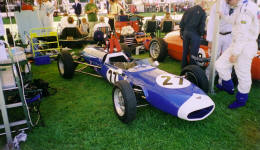
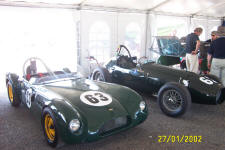 Nota
were making purpose built Monoposto racing cars for the likes of Barry Garner,
who used them for hill climbs with the Nota Consol and his Nota Major in which
he won the NSW Hill climb Championship. They also introduced Formula Junior
Racing Cars to Australia and in 1960 made Australia’s first mid-engined Formula
Junior. Whilst Nota were building single seater racing cars, they were also
building sports cars, both in clubman style and all enveloping alloy Streamliner
sports cars. These alloy Streamliners and all of Nota alloy bodies were built by
Jack Wiffen who, aside from making countless alloy bodies for Nota, was
responsible for Donald Campbell’s Land Speed Record breaking Blue Bird.
Nota
were making purpose built Monoposto racing cars for the likes of Barry Garner,
who used them for hill climbs with the Nota Consol and his Nota Major in which
he won the NSW Hill climb Championship. They also introduced Formula Junior
Racing Cars to Australia and in 1960 made Australia’s first mid-engined Formula
Junior. Whilst Nota were building single seater racing cars, they were also
building sports cars, both in clubman style and all enveloping alloy Streamliner
sports cars. These alloy Streamliners and all of Nota alloy bodies were built by
Jack Wiffen who, aside from making countless alloy bodies for Nota, was
responsible for Donald Campbell’s Land Speed Record breaking Blue Bird.
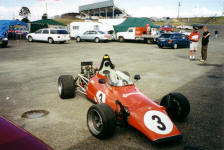 Nota introduced Formula Vee’s to
Australia. Building Australia’s first Vee’s for Warwick Farm racing circuit
making 34 cars in the first year of production to get the formula under way with
drivers like Peter Findlay winning the Formula Vee Championship in his Nota Vee.
Nota introduced Formula Vee’s to
Australia. Building Australia’s first Vee’s for Warwick Farm racing circuit
making 34 cars in the first year of production to get the formula under way with
drivers like Peter Findlay winning the Formula Vee Championship in his Nota Vee.
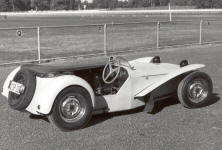 During the 60’s Nota introduced
their Nota Sportsman, a clubman sports car which they still produce today, with
over 100 being produced. David Medley won the Clubman Championship in 1968 in
his Nota, one of 7 Clubman Championships that Nota have won.
During the 60’s Nota introduced
their Nota Sportsman, a clubman sports car which they still produce today, with
over 100 being produced. David Medley won the Clubman Championship in 1968 in
his Nota, one of 7 Clubman Championships that Nota have won.
Nota were innovators; aside from
their racing cars they built many road cars as well. Initially building their
alloy clad Streamliners which were followed by their range of `Sapphires` in
both roadster versions and coupes with Ford, Fiat Twin Cam and Coventry Climax
engines. In 1963 Nota built a mid-engined Mini powered sports car putting BMC’s
engine transversely behind the driver, the first in Australia, and possibly the
world, which was probably the instigator of the Fang of later years.
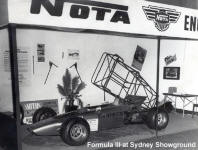 Guy’s cars were continuing to win
races. Notas have won numerous championships in various racing formats as well
as hill climbs, with both sports cars and monoposto single seater racing cars in
the hands many drivers. Nota also introduced Formula III mid-engined cars to
Australia making Australia’s first, and then following up with their Formula
Fords.
Guy’s cars were continuing to win
races. Notas have won numerous championships in various racing formats as well
as hill climbs, with both sports cars and monoposto single seater racing cars in
the hands many drivers. Nota also introduced Formula III mid-engined cars to
Australia making Australia’s first, and then following up with their Formula
Fords.
Guy lent his hand to other ventures
as well, he designed the original track at Oran Park race circuit as well as
having a program on channel 9 relating to engine development and suspension
design. Guy Buckingham, an excellent engineer, really wasn’t interested in body
design. That was Chris Buckingham’s passion, he loved body styling and whilst
initially he just made cars with a good looking bodies, he went onto compliment
this by studying aerodynamics at university. He has been involved with Nota’s
body styling ever since.
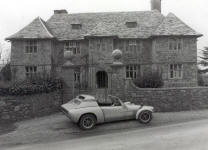 His initial designs were done when he was still at
school, including the Nota Fang. One of Guy's customers wrote off his Mini
Cooper S and, as it wasn’t repairable, Chris convinced Guy into buying it. The
engine gearbox and sub frame were used to build a sports car with the Cooper S
engine behind the driver bolted to the chassis’s rear bulkhead. The front
suspension was taken from one of Nota’s Clubman cars. These mechanicals and
chassis were then clothed in a distinctive body. It was an instant success and
while it used a lot of the components from other Notas it was Chris’s design and
he designed it whilst he was still at school. What made the Fang such a success
though, apart from its distinctive looks, was the principle Nota still has
today. "Make a car that is light with a good power to weight ratio". Cars which
are light will have all manner of other benefits as well, they will stop far
quicker and have less wash out weight whilst cornering. Light cars just work
better!
His initial designs were done when he was still at
school, including the Nota Fang. One of Guy's customers wrote off his Mini
Cooper S and, as it wasn’t repairable, Chris convinced Guy into buying it. The
engine gearbox and sub frame were used to build a sports car with the Cooper S
engine behind the driver bolted to the chassis’s rear bulkhead. The front
suspension was taken from one of Nota’s Clubman cars. These mechanicals and
chassis were then clothed in a distinctive body. It was an instant success and
while it used a lot of the components from other Notas it was Chris’s design and
he designed it whilst he was still at school. What made the Fang such a success
though, apart from its distinctive looks, was the principle Nota still has
today. "Make a car that is light with a good power to weight ratio". Cars which
are light will have all manner of other benefits as well, they will stop far
quicker and have less wash out weight whilst cornering. Light cars just work
better!
The Nota Fang was quite a car,
perhaps not as technically advanced as the Nota Chimera but pretty formable and
had
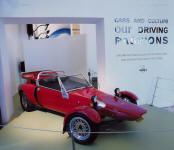 outstanding performance per dollar. Many considered the Phase III GTHO the
super car of the 70’s, which had 190 bhp/ton, yet the Fang had a considerably
better figure of 280 bhp/ton. I guess that’s why David Whitehouse in his Nota
Fang took the Hill climb record at Noosa Hill Climb from a 5 litre V8 TVR. The
Powerhouse Museum now owns a Nota Fang. They bought one because they were
impressed with its technical innovations and put it on display in their front
foyer in the NRMA’s Power and Passion Exhibition along with Jack Brabham’s
Formula I Championship winning car. The Fang was quite an achievement when you
consider its designer, Chris Buckingham, was still at school when he designed
it. It had quite a good production run too, with 117 being produced with the BMC
mechanicals. The Fang has evolved from the BMC mechanicals, initially using
Lancia 2 litre engine gearbox componentry, then Toyota 4 cylinder engines and
has finally evolved into V6 FI’s of today with Fangs in all incarnations
reaching nearly 200 cars.
outstanding performance per dollar. Many considered the Phase III GTHO the
super car of the 70’s, which had 190 bhp/ton, yet the Fang had a considerably
better figure of 280 bhp/ton. I guess that’s why David Whitehouse in his Nota
Fang took the Hill climb record at Noosa Hill Climb from a 5 litre V8 TVR. The
Powerhouse Museum now owns a Nota Fang. They bought one because they were
impressed with its technical innovations and put it on display in their front
foyer in the NRMA’s Power and Passion Exhibition along with Jack Brabham’s
Formula I Championship winning car. The Fang was quite an achievement when you
consider its designer, Chris Buckingham, was still at school when he designed
it. It had quite a good production run too, with 117 being produced with the BMC
mechanicals. The Fang has evolved from the BMC mechanicals, initially using
Lancia 2 litre engine gearbox componentry, then Toyota 4 cylinder engines and
has finally evolved into V6 FI’s of today with Fangs in all incarnations
reaching nearly 200 cars.
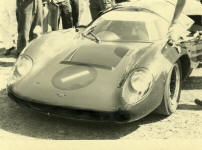
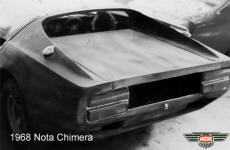 Prior to the Fang, Nota were
involved with another sports car, the Nota Chimera, which Chris also designed.
It was a true mid-engined GT car and utilised suspension componentry from Nota’s
FIII. Its chassis had an alloy tub with 2 sub frames; one for the front
suspension and the the other for rear sub frame which utilized the roll bar
structure and doubled as the pick up for the engine mounts and rear suspension.
A number of engines were to be used in the Chimera including the Ford V6 unit.
Unfortunately only a few were made as the costs weren’t considered viable by
Guy.
Prior to the Fang, Nota were
involved with another sports car, the Nota Chimera, which Chris also designed.
It was a true mid-engined GT car and utilised suspension componentry from Nota’s
FIII. Its chassis had an alloy tub with 2 sub frames; one for the front
suspension and the the other for rear sub frame which utilized the roll bar
structure and doubled as the pick up for the engine mounts and rear suspension.
A number of engines were to be used in the Chimera including the Ford V6 unit.
Unfortunately only a few were made as the costs weren’t considered viable by
Guy.
After the Chimeras and Fangs came
the Nota Marauders. The initial cars were made with the Cooper S mechanicals
that the Fang used, but it weighed an extra 65kgs in Cabriole and 83kgs in GT
format.
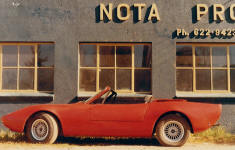 Unfortunately Leyland was in the process of stopping supply of Clubman
GT componentry so a new set of mechanicals needed to be found. Chris felt the
Lancia was a good option and a number of Marauders were made with second hand 2
litre Lancia mechanicals, but when Fiat/Lancia were approached about the supply
of new componentry they didn’t want to supply the parts. Probably as they felt
it would compete with their XI9. Mean while Nota were building a Formula 5000
using a P76 alloy V8 and Chris thought this was a good engine for the Marauder
but unfortunately Leyland decided to shut down the P76 project before the new
Marauder was completed. Again Nota were faced with lack of supply, and had a
similar scenario with the Ford 351 V8 that they were going to use in the car.
Both of these mid-engined Marauders used the engine at the rear with the gearbox
facing forwards, beside the driver. The gearbox was then coupled to a Nota
transfer case which delivered power to the front and rear suspensions. Pity, the
4 wheel drive mid-engined Marauders were shelved as they were very technically
advanced. They would have been something!
Unfortunately Leyland was in the process of stopping supply of Clubman
GT componentry so a new set of mechanicals needed to be found. Chris felt the
Lancia was a good option and a number of Marauders were made with second hand 2
litre Lancia mechanicals, but when Fiat/Lancia were approached about the supply
of new componentry they didn’t want to supply the parts. Probably as they felt
it would compete with their XI9. Mean while Nota were building a Formula 5000
using a P76 alloy V8 and Chris thought this was a good engine for the Marauder
but unfortunately Leyland decided to shut down the P76 project before the new
Marauder was completed. Again Nota were faced with lack of supply, and had a
similar scenario with the Ford 351 V8 that they were going to use in the car.
Both of these mid-engined Marauders used the engine at the rear with the gearbox
facing forwards, beside the driver. The gearbox was then coupled to a Nota
transfer case which delivered power to the front and rear suspensions. Pity, the
4 wheel drive mid-engined Marauders were shelved as they were very technically
advanced. They would have been something!
Chris, disillusioned, left for
England, the Mecca of Formula I, and worked with a number of sports and racing
car manufacturers picking up on the latest developments in materials and design.
Returning to Australia, he assembled a team from aircraft, car and bike racing
to implement new Nota projects. Initially they made a revised Fang design with a
4Age Toyota engine but Chris was looking to develop a new car not just revise
existing ones. Even so the Fang is still available today, the current Fangs are
now fitted with Honda Civic engines and are still a pretty formidable sports car
and a popular one too.
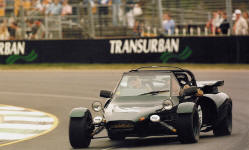 Finally good luck intervened and
Toyota offered Chris the components he needed for his new project with an engine
transaxle from the 2 litre Camry and the spin off was that the same engine
mounts could be used for Toyota’s new 3 litre V6 engines. Enter the Nota FI
which was a bigger car, Nota offering it with 3 engines: Toyota’s 2 litre 4’s in
natural aspiration or their 2 litre turbo and the 3 litre quad cam V6 . Again
Nota had an instant success and are now offering a revised FI with a Toyota
Aurion engine. This when used with Nota’s revised air intake and exhaust gives
over 215kw in the naturally aspirated version. The intercooled super charged
version develops over 300kws and this is in a car which weighs around 680kgs.
Unfortunately not everyone likes the styling of the FI so Nota are now offering
these mechanicals in their new Le Mans as well. We have now commissioned the
making of a full rap round GT windscreen for the new GT version of the Le Mans,
we may even see one being used in the GT Championship against the Lambo’s and
Ferrari’s.
Finally good luck intervened and
Toyota offered Chris the components he needed for his new project with an engine
transaxle from the 2 litre Camry and the spin off was that the same engine
mounts could be used for Toyota’s new 3 litre V6 engines. Enter the Nota FI
which was a bigger car, Nota offering it with 3 engines: Toyota’s 2 litre 4’s in
natural aspiration or their 2 litre turbo and the 3 litre quad cam V6 . Again
Nota had an instant success and are now offering a revised FI with a Toyota
Aurion engine. This when used with Nota’s revised air intake and exhaust gives
over 215kw in the naturally aspirated version. The intercooled super charged
version develops over 300kws and this is in a car which weighs around 680kgs.
Unfortunately not everyone likes the styling of the FI so Nota are now offering
these mechanicals in their new Le Mans as well. We have now commissioned the
making of a full rap round GT windscreen for the new GT version of the Le Mans,
we may even see one being used in the GT Championship against the Lambo’s and
Ferrari’s.
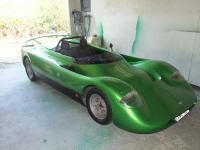 The Le Mans was the next major
project for Nota and it started out as a racing car. The car was made for 2C
Super Sport racing, initially with a 1300cc Suzuki GTi engine and then used a
Hayabusa motor bike engine. The Suzuki engined car weighing 423kgs and the
Hayabusa engined car weighed 403kgs. Nota’s customers on seeing the 2C car kept
saying “it’s like it’s just come from Le Mans 24 hour race.” Hence the name for
the Le Mans but they wanted Le Mans sports cars for use on the road. The
rigmarole that the R.T.A. put the car through was extensive. The RTA just didn’t
want a “racing car on the road”. Eventually though, they saw that the Le Mans
was exceptionally safe and road worthy giving it approval. Initially the road
cars used the Suzuki GTi engines weighing 520kgs. Further Le Mans cars have been
fitted with Celica and Honda engines.
The Le Mans was the next major
project for Nota and it started out as a racing car. The car was made for 2C
Super Sport racing, initially with a 1300cc Suzuki GTi engine and then used a
Hayabusa motor bike engine. The Suzuki engined car weighing 423kgs and the
Hayabusa engined car weighed 403kgs. Nota’s customers on seeing the 2C car kept
saying “it’s like it’s just come from Le Mans 24 hour race.” Hence the name for
the Le Mans but they wanted Le Mans sports cars for use on the road. The
rigmarole that the R.T.A. put the car through was extensive. The RTA just didn’t
want a “racing car on the road”. Eventually though, they saw that the Le Mans
was exceptionally safe and road worthy giving it approval. Initially the road
cars used the Suzuki GTi engines weighing 520kgs. Further Le Mans cars have been
fitted with Celica and Honda engines.
Now Nota have made the Le Mans
bigger, redesigning it completely and revising the aerodynamics. Initially
designing a through-the-nose internal wing which is used to complement the
underfloor diffuser. The side panels have been radiused and the air intake
tunnels for the radiators and induction system have been revised. The car has
had a 20 percent increase in the passenger area and it is also offered with
optional doors and is even available in a GT format. The current Le Mans having
an extensive remake to accommodate the new Toyota Aurion engine in both natural
aspiration and intercooled super charge forms, the intercooled super charged
versions running at over 300kws and all in a car that weighs as little as
680kgs.
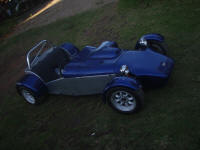 Nota are also developing a
mid-engined traditional bodied Clubman car, as Honda are stopping production of
the S2000 which Nota use in their front engined Clubman. This mid-engined design
allows the use of many front wheel drive units from a large range of
manufacturers. The mid-engined clubman uses the nose and guards from Nota’s
front engined Clubman as well as the front 90% of the chassis, only the chassis
behind the seat bulkhead is different where 100mm has been added into the rear
body hoops. It is then clad with alloy panelling just like all of the earlier
Nota Clubmans. In fact you wouldn’t be able to tell the mid-engined from the
front engined cars apart unless the engine compartment panels were open. There
are other benefits too; the engine transaxle weighs about 40 kgs less than a
traditional engine, gearbox, tail shaft and differential. The interior of the
cockpit has considerably more room as there is no engine and gear box were the
passenger cockpit is, there is no tail shaft tunnel either giving much more room
for the larger driver. The car will handle better too, as the main weight is on
the drive wheels. Further the revised weight distribution gives the car a better
and more comfortable ride without compromising the handling. All of these points
are a pretty good reason to use this new format.
Nota are also developing a
mid-engined traditional bodied Clubman car, as Honda are stopping production of
the S2000 which Nota use in their front engined Clubman. This mid-engined design
allows the use of many front wheel drive units from a large range of
manufacturers. The mid-engined clubman uses the nose and guards from Nota’s
front engined Clubman as well as the front 90% of the chassis, only the chassis
behind the seat bulkhead is different where 100mm has been added into the rear
body hoops. It is then clad with alloy panelling just like all of the earlier
Nota Clubmans. In fact you wouldn’t be able to tell the mid-engined from the
front engined cars apart unless the engine compartment panels were open. There
are other benefits too; the engine transaxle weighs about 40 kgs less than a
traditional engine, gearbox, tail shaft and differential. The interior of the
cockpit has considerably more room as there is no engine and gear box were the
passenger cockpit is, there is no tail shaft tunnel either giving much more room
for the larger driver. The car will handle better too, as the main weight is on
the drive wheels. Further the revised weight distribution gives the car a better
and more comfortable ride without compromising the handling. All of these points
are a pretty good reason to use this new format.
Yes! You would have to say Nota,
who celebrated their 50th
anniversary in 2002, have produced some amazing and innovative sports and racing
cars and hopefully will continue to do so.
Chris Buckingham
Nota Sports and Racing Cars
 Back to top
Back to top

 Nota
were making purpose built Monoposto racing cars for the likes of Barry Garner,
who used them for hill climbs with the Nota Consol and his Nota Major in which
he won the NSW Hill climb Championship. They also introduced Formula Junior
Racing Cars to Australia and in 1960 made Australia’s first mid-engined Formula
Junior. Whilst Nota were building single seater racing cars, they were also
building sports cars, both in clubman style and all enveloping alloy Streamliner
sports cars. These alloy Streamliners and all of Nota alloy bodies were built by
Jack Wiffen who, aside from making countless alloy bodies for Nota, was
responsible for Donald Campbell’s Land Speed Record breaking Blue Bird.
Nota
were making purpose built Monoposto racing cars for the likes of Barry Garner,
who used them for hill climbs with the Nota Consol and his Nota Major in which
he won the NSW Hill climb Championship. They also introduced Formula Junior
Racing Cars to Australia and in 1960 made Australia’s first mid-engined Formula
Junior. Whilst Nota were building single seater racing cars, they were also
building sports cars, both in clubman style and all enveloping alloy Streamliner
sports cars. These alloy Streamliners and all of Nota alloy bodies were built by
Jack Wiffen who, aside from making countless alloy bodies for Nota, was
responsible for Donald Campbell’s Land Speed Record breaking Blue Bird.







